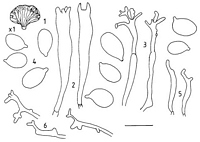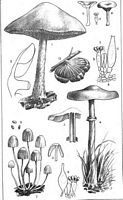|
 Anthracophyllum glaucophyllum Anthracophyllum glaucophyllum
SynonymsXerotus glaucophyllus
Xerotus berteroi
BiostatusPresent in region - Indigenous. Endemic
Images (click to enlarge)
Caption: 1, Basidiome x l (dried material) 2, basidia; 3, hyphoid pleurocystidia; 4, spores; 5, hyphoid cheilocystidia; 6, pileipellis elements. (Magnifications, see Fig. 1.) | 
Caption: Fig. 13. Xerotus glaucophyllus, Cke. and Mass.; natural size. |
Article: Segedin, B.P. (1994). Studies in the Agaricales of New Zealand: new records and new species of the genera Cheimonophyllum, Mniopetalum, and Anthracophyllum (Tricholomataceae, Collybieae). New Zealand Journal of Botany 32: 61-72 (http://www.rsnz.org/publish/abstracts.php).
Description: Description of the holotype (Cooke 1892)
Pilei flabelliformi, tenui plerumque sublobato, sulcato, glabro, opaco, siccitate atro (1.5-2.5 cm) margine abrupte recurvo; lamellis paucis, distantibus, latis, acutis, venoso-connexis, pallide lateritiis, siccitate argillaceo-glaucibus. Sporis globosis, 6 µm diam.
Additional information from the holotype:
Basidiome 15-30 x 8-20 mm diam., fan-shaped to somewhat reniform, laterally stipitate. Pileus broadly sulcate, margin undulate, scarcely inrolled except in 1 small specimen, otherwise plane, black, surface finely granular. Hymenophore dark brown (5E6) to very dark brown. Lamellae in 3 series with at least 9 principal ones in the bigger basidiomes, fairly close, broad and thin in some specimens, thick and shallow and more separated in others. In the latter case, some interveining present near margin of pileus. Stipe very small, more distinct in small basidiomes.
Spores 7-10 x 4.5-7 (8.5 x 5.5) µm, Q = 1.55, ovo-ellipsoid, variable in size which may be associated with the presence of both 2- and 4-spored basidia, inamyloid, not dextrinoid, acyanophilic, thin-walled, collapsing readily towards the basal end and appearing lacrymoid, contents with a number of refractile granules. Basidia 38-70 x 7 µm, cylindrico-clavate, 2 4-spored, sterigmata up to 6 µm in length. Hyphoid pleurocystidia are common, 45-50 x 3-4 µm, hyaline and thin-walled, irregularly narrow-clavate, often with a medial constriction and with several fine branches at the tips. Hyphoid cheilocystidia few on the heteromorphous lamellar margin, 22-25 x 2.5-3 µm, flexuose-cylindric with 1 or more irregular, short, narrow branches at the apex, hyaline, thin-walled. Trama of irregularly interwoven, hyaline, thickwalled, very uniform hyphae, 4-6 µm diam., with conspicuous but infrequent clamp-connections and no green-staining pigment. Subhymenium well-developed, filamentous. Both hymenium and subhymenium coloured a bright yellow-brown in KOH. A reddish brown pigment diffuses out into the KOH medium, possibly derived from the hymenium. Context of similar hyphae to the trama. Pileipellis of semi-erect narrow hyphae (2-3 µm diam.), with irregular nodulose to weakly diverticulate hyphal endings. The characteristic green-staining pigment seems to emanate mainly from the pileipellis and stains some or all of the context green in some basidiomes. In others the pigment occurs as patches or only as minute specks of green, scattered through the context.
Habitat: On twigs. New Zealand (Cooke 1892).
Notes: No material of this species seems to have been collected since Colenso's time, but in a duplicate collection of Colenso's specimens, housed at PDD, there is a folder bearing the same number as the type (1193) and containing four packets of specimens and a scrap of paper with the following inscription in Colenso's handwriting "Hymen. Light brick red fresh. April 1/90, on dead tree, beyond Chinese". Notes from other Colenso collections suggest that this material would have been collected near Dannevirke, North Island. One packet labelled "best" and "pale brick" in Colenso's handwriting contains several almost intact basidiomes in a good state of preservation, all showing pale brown (5D4) hymenophores with a faint glaucous sheen, whereas all the other specimens, including the type, are very dark brown in the dried state. Evidently it is from this packet that Cooke (1892) took his description.
The glaucous colour in the dried state seems somewhat unusual and should be confirmed. The green-staining character was very evident in basidiomes of this collection, but spores were not plentiful and mostly rather small and subspherical, with a diameter of 6-7 µm, as noted by Cooke, perhaps indicating that the basidiomes were immature.
The description of the type of A. glaucophyllum differs from the other species described by Pegler & Young (1989) in characters such as the colour of the fresh hymenophore and the glaucous colour when dried, somewhat smaller size of the spores, the colour of the context and trama as well as hymenial and subhymenial layers, the structure of the hyphoid pleurocystidia, and the large size of the basidia. In spore size and general morphology it seems closest to the tropical species A. nigritum (Lev.) Kalchbr. but the latter has a hymenophore of a different colour, smaller, tetrasporic basidia, no hyphoid pleurocystidia, and sometimes a rudimentary stipe.
Article: Massee, G.E. (1899) [1898]. The fungus flora of New Zealand. Transactions and Proceedings of the New Zealand Institute 31: 282–349 Wellington:.
Description: Pileus sessile, very thin, horizontal, fan-shaped or irregularly circular in outline, margin
sometimes slightly lobed, attached laterally, glabrous, more or less fluted, extreme edge often
upturned, dusky (when dry), 1.5-2-5 cm. across; gills few, distant, broad, with shorter
intermediate ones radiating from the point of attachment, pale brick-red, then becoming
glaucous with the white globose spores, which are about 6 µ. diameter.
Habitat: On slender twigs.
Distribution: New Zealand.
Notes: Distinguished by the broad gills and the extreme margin of the pileus upturned, at least when
dry. The species of Xerotus are remarkable for becoming dingy in colour and, in many
instances, black when dry.
|